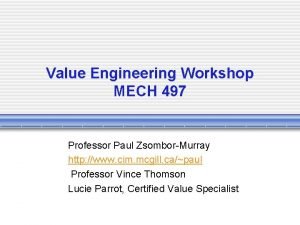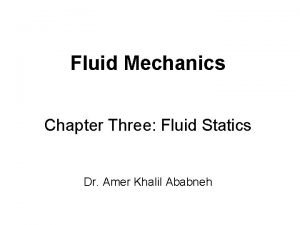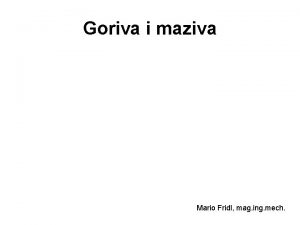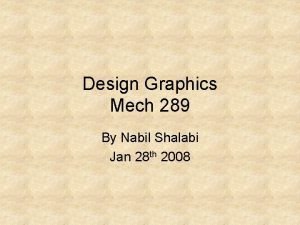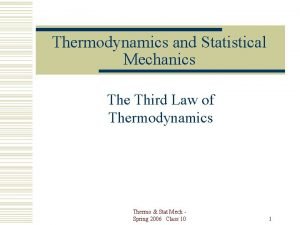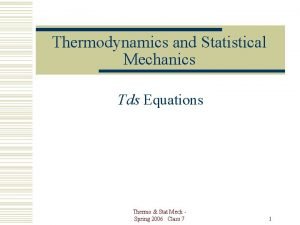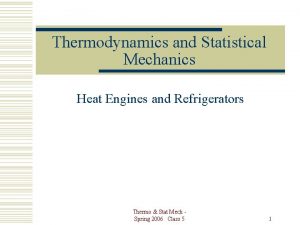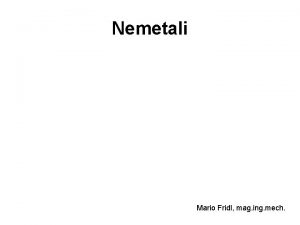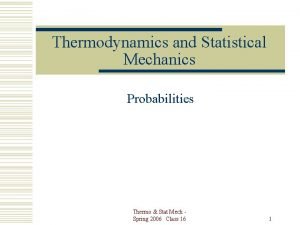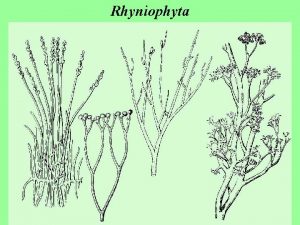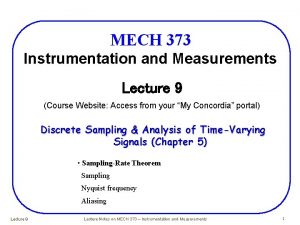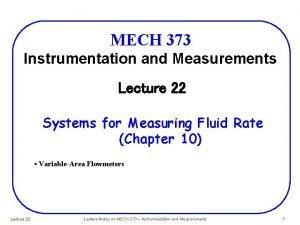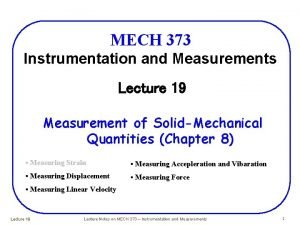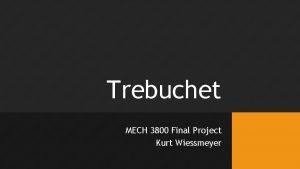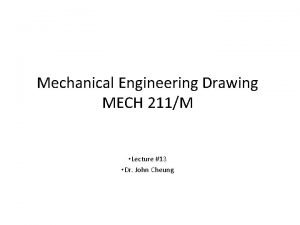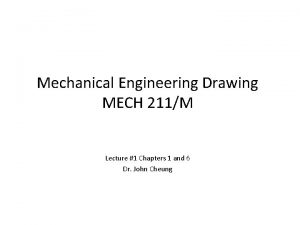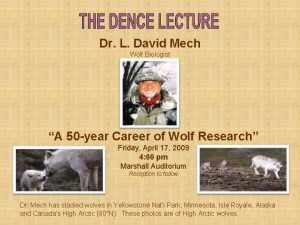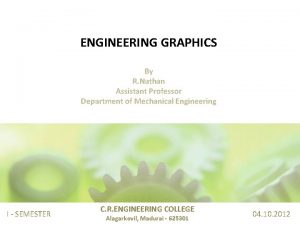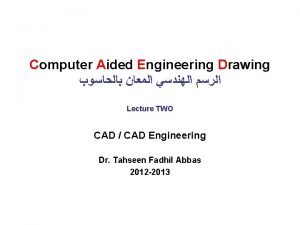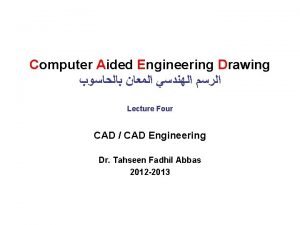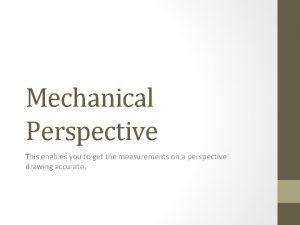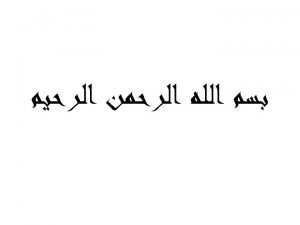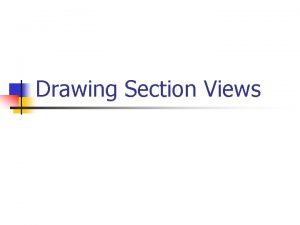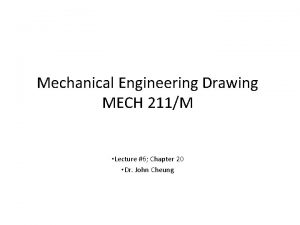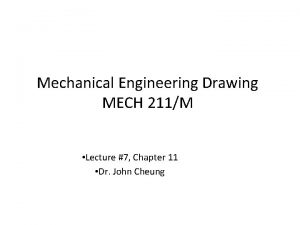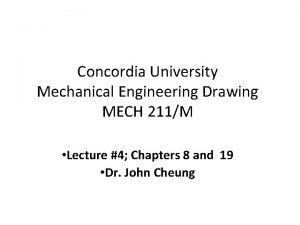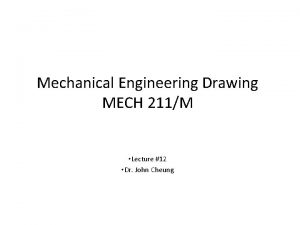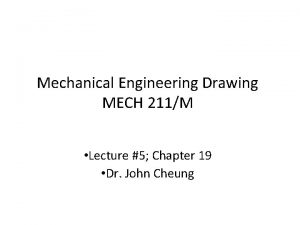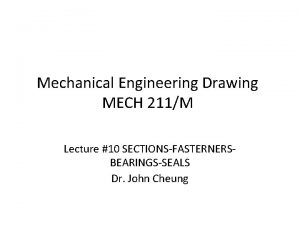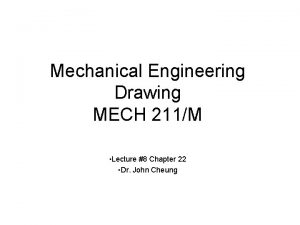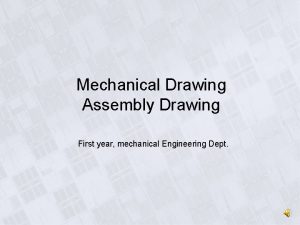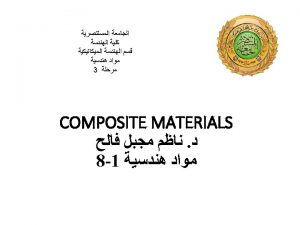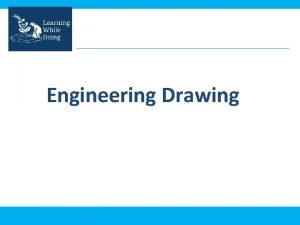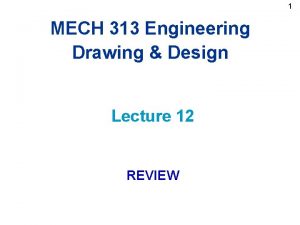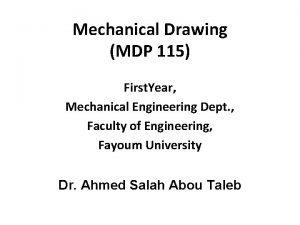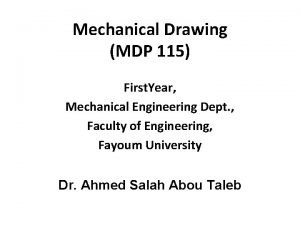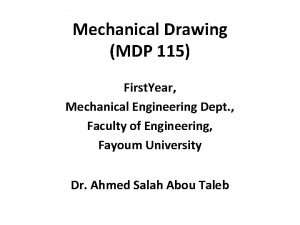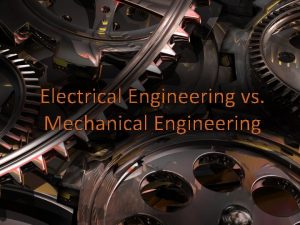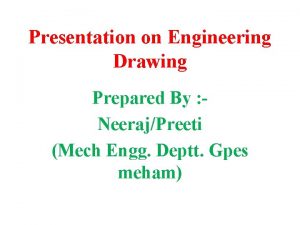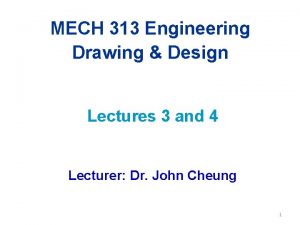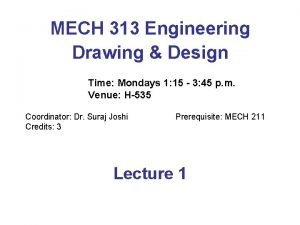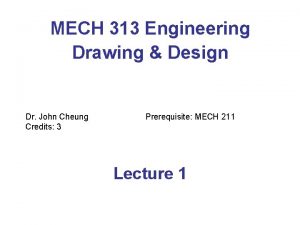Mechanical Engineering Drawing MECH 211M Lecture 1 Chapters
































- Slides: 32

Mechanical Engineering Drawing MECH 211/M Lecture #1 Chapters 1 and 6 Dr. John Cheung

Technical vs. Artistic Drawings 2

What makes a good technical drawing? 3

What makes a good technical drawing? Should represent the concept/object clearly Does not cause any uncertainty about the details Drawn in a way that reduces complexity of the drawing Complies with standards Neat and clean Provides all information needed Well organized on the paper 4

Types of Projection Drawings 5

Two Major Projections Types

Common Parallel Projection Types Oblique Projection Orthographic Projection Isometric Projection Mult-iview Projection

Multiview Projection 8

Position of Projections 9

Position of Projections 10

First vs. Third Angle Projection UK used this convention. Third Angle Projection First Angle Projection 11

Object Orientation 12

Techniques for Transferring Dimensions 13

How to Transfer Points Using Miter Line 14

How to Transfer Points Using Miter Line 15

How to Transfer Points Using Miter Line 16

How to Transfer Points Using Miter Line Folding lines needed in the drawing. 17

Breaking the General Rules Alternate Positions Can be used for notes. 18

Breaking the General Rules Partial Views Show the importance of the area. Detail information specified. 19

Breaking the General Rules Revolution Conventions Profile view – too many hidden lines, web – confusing. Too many hidden lines. 20

Breaking the General Rules Revolution Conventions Rotate features round 21

Surfaces 1. A surface that is perpendicular to the plane of projection it is seen as. . . ? (surface, edge (line), point) 2. A surface that is parallel to the plane of projection (Normal Surface) it is seen as. . . ? (true size, foreshortened) (surface, edge, point) 3. A surface that is at an angle to the plane of projection (Oblique Surface) it is seen as. . . ? (true size, foreshortened) (surface, edge, point) 22

Surfaces 1. A surface that is perpendicular to the 1. As a line (edge plane of projection it is seen as. . . ? (surface, edge, point) view) 2. A surface that is parallel to the plane of projection (Normal Surface) it is seen as 2. True size. . . ? (true size, foreshortened) (surface, edge, point) surface 3. A surface that is at an angle to the plane of projection (Oblique Surface) it is seen 3. Foreshortened as. . . ? (true size, foreshortened) (surface, surface edge, point) 23

Normal Surface and Edge Normal Surface: A plane surface that is parallel to a plane of projection. E. g. Plane A // to horizontal projection plane. Normal Edge: A line that is perpendicular to a plane of projection. E. g. Edge D Prep. to profile plane of projection, hence appears as a point 17 and true length on other planes. Edge D Profile plane of projection 24

Inclined Surface and Edge Inclined Surface: A plane surface that is perpendicular to one plane of projection but inclined to adjacent planes Inclined Edge: Is parallel to a plane of projection but inclined to adjacent planes 25

Oblique Surface and Edge Oblique Surface: A plane that is oblique to all planes of projection Oblique Line: Oblique to all planes of projection 26

A View in Isolation This is a top view of on object. Sketch some possibilities of what this could be.

A View in Isolation The height can vary Angled surfaces are the same as in plane surfaces Curved surfaces also appear the same 28

Similar Shapes in Different Views In adjacent views the general shape will be maintained Widths of the arms may change Orientation will be rotated 90° 29

Parallel Edges If a series of parallel planes is intersected by another plane the resulting lines of intersection are parallel If two lines are parallel in a view, their projections in other views will be parallel 30

Cylinders Circles appear as ellipses if the plane of projection is oblique Ellipses are drawn with: – A template – Transferring many points and the drawing a smooth curve between them 31

Quiz Next Class 6. 32 Intersection and Tangencies 6. 33 How to Represent Holes 6. 34 Fillets and Rounds 6. 35 Rounds 32
 Standard mechanical engineering drawing scales
Standard mechanical engineering drawing scales 01:640:244 lecture notes - lecture 15: plat, idah, farad
01:640:244 lecture notes - lecture 15: plat, idah, farad Isometric shading
Isometric shading Paul zsombor-murray
Paul zsombor-murray Mehanika fluida ftn
Mehanika fluida ftn Minimum volume
Minimum volume Mag ing mech
Mag ing mech Nabil
Nabil Stat mech
Stat mech The first tds equation is
The first tds equation is Stat mech
Stat mech Mag ing mech
Mag ing mech Thermodynamic probability
Thermodynamic probability Mech se špičatými lístky
Mech se špičatými lístky Mech robotix
Mech robotix Mech
Mech Mech
Mech Mech
Mech Trebuchet mech
Trebuchet mech Backstop mechanical engineering
Backstop mechanical engineering Dihedral angle engineering drawing
Dihedral angle engineering drawing Dr david mech
Dr david mech Actual mechanical advantage vs ideal mechanical advantage
Actual mechanical advantage vs ideal mechanical advantage Drawing lecture
Drawing lecture Drawing lecture
Drawing lecture Engineering drawing
Engineering drawing Financial engineering notes
Financial engineering notes Requirement analysis in software engineering notes
Requirement analysis in software engineering notes Foundation engineering lecture notes
Foundation engineering lecture notes Engineering ethics lecture notes
Engineering ethics lecture notes One point perspective from plan and elevation
One point perspective from plan and elevation Engineering drawing lines
Engineering drawing lines Rotated section view
Rotated section view



